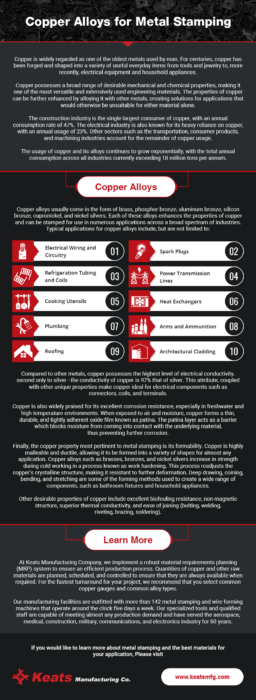Copper is widely regarded as one of the oldest metals used by man. For centuries, copper has been forged and shaped into a variety of useful everyday items from tools and jewelry to, more recently, electrical equipment and household appliances.
Copper possesses a broad range of desirable mechanical and chemical properties, making it one of the most versatile and extensively used engineering materials. The properties of copper can be further enhanced by alloying it with other metals, creating solutions for applications that would otherwise be unsuitable for either material alone.
The construction industry is the single largest consumer of copper, with an annual consumption rate of 47%. The electrical industry is also known for its heavy reliance on copper, with an annual usage of 23%. Other sectors such as the transportation, consumer products, and machining industries account for the remainder of copper usage.
The usage of copper and its alloys continues to grow exponentially, with the total annual consumption across all industries currently exceeding 18 million tons per annum.
Copper Alloys
Copper alloys usually come in the form of brass, phosphor bronze, aluminum bronze, silicon bronze, cupronickel, and nickel silvers. Each of these alloys enhances the properties of copper and can be stamped for use in numerous applications across a broad spectrum of industries. Typical applications for copper alloys include, but are not limited to:
- Electrical wiring and circuitry
- Spark plugs
- Refrigeration tubing and coils
- Power transmission lines
- Cooking utensils
- Heat exchangers
- Plumbing
- Arms and ammunition
- Roofing
- Architectural cladding
Compared to other metals, copper possesses the highest level of electrical conductivity. second only to silver—the conductivity of copper is 97% that of silver. This attribute, coupled with other unique properties make copper ideal for electrical components such as connectors, coils, and terminals.
Copper is also widely praised for its excellent corrosion resistance, especially in freshwater and high-temperature environments. When exposed to air and moisture, copper forms a thin, durable, and tightly adherent oxide film known as patina. The patina layer acts as a barrier which blocks moisture from coming into contact with the underlying material, thus preventing further corrosion.
Finally, the copper property most pertinent to metal stamping is its formability. Copper is highly malleable and ductile, allowing it to be formed into a variety of shapes for almost any application. Copper alloys such as brasses, bronzes, and nickel silvers increase in strength during cold working in a process known as work hardening. This process readjusts the copper’s crystalline structure, making it resistant to further deformation. Deep drawing, coining, bending, and stretching are some of the forming methods used to create a wide range of components, such as bathroom fixtures and household appliances.
Other desirable properties of copper include excellent biofouling resistance, non-magnetic structure, superior thermal conductivity, and ease of joining (bolting, welding, riveting, brazing, soldering).
Learn More about Copper Metal Stamping
At Keats Manufacturing Company, we implement a robust material requirements planning (MRP) system to ensure an efficient production process. Quantities of copper and other raw materials are planned, scheduled, and controlled to ensure that they are always available when required. For the fastest turnaround for your project, we recommend that you select common copper gauges and common alloy types.
Our manufacturing facilities are outfitted with more than 142 metal stamping and wire forming machines that operate around the clock five days a week. Our specialized tools and qualified staff are capable of meeting almost any production demand and have served the aerospace, medical, construction, military, communications, and electronics industry for 60 years.
If you would like to learn more about metal stamping and the best materials for your application, feel free to download our free eBook: Choosing the Best Raw Materials.



Comments are closed